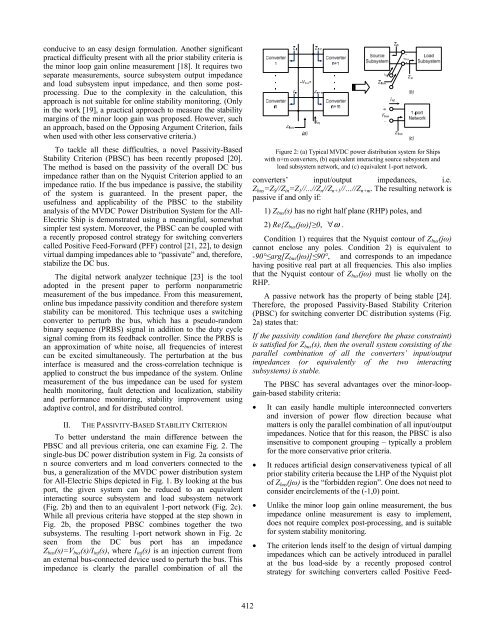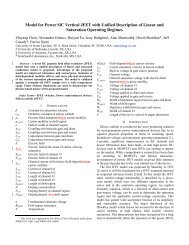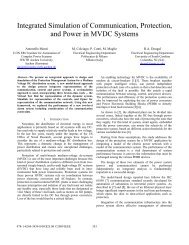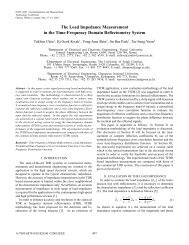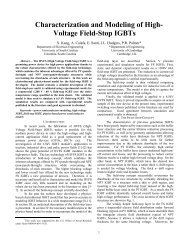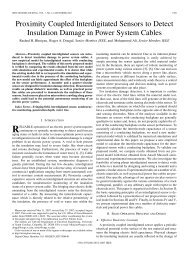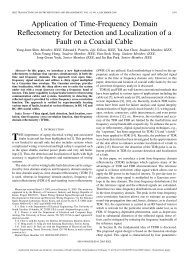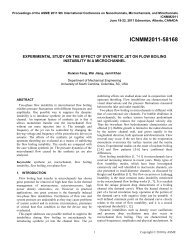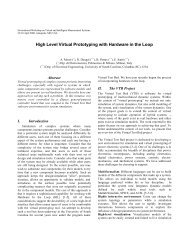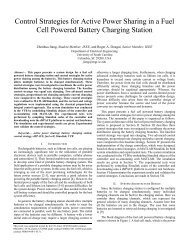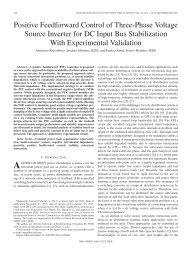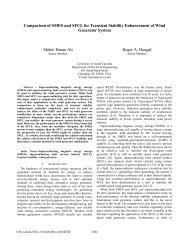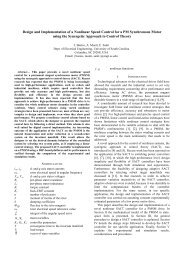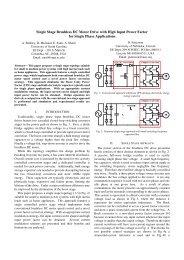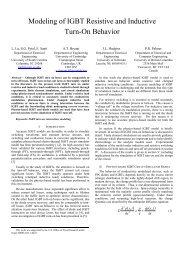Stability Analysis of an All-Electric Ship MVDC Power Distribution ...
Stability Analysis of an All-Electric Ship MVDC Power Distribution ...
Stability Analysis of an All-Electric Ship MVDC Power Distribution ...
You also want an ePaper? Increase the reach of your titles
YUMPU automatically turns print PDFs into web optimized ePapers that Google loves.
conducive to <strong>an</strong> easy design formulation. Another signific<strong>an</strong>t<br />
practical difficulty present with all the prior stability criteria is<br />
the minor loop gain online measurement [18]. It requires two<br />
separate measurements, source subsystem output imped<strong>an</strong>ce<br />
<strong>an</strong>d load subsystem input imped<strong>an</strong>ce, <strong>an</strong>d then some postprocessing.<br />
Due to the complexity in the calculation, this<br />
approach is not suitable for online stability monitoring. (Only<br />
in the work [19], a practical approach to measure the stability<br />
margins <strong>of</strong> the minor loop gain was proposed. However, such<br />
<strong>an</strong> approach, based on the Opposing Argument Criterion, fails<br />
when used with other less conservative criteria.)<br />
To tackle all these difficulties, a novel Passivity-Based<br />
<strong>Stability</strong> Criterion (PBSC) has been recently proposed [20].<br />
The method is based on the passivity <strong>of</strong> the overall DC bus<br />
imped<strong>an</strong>ce rather th<strong>an</strong> on the Nyquist Criterion applied to <strong>an</strong><br />
imped<strong>an</strong>ce ratio. If the bus imped<strong>an</strong>ce is passive, the stability<br />
<strong>of</strong> the system is guar<strong>an</strong>teed. In the present paper, the<br />
usefulness <strong>an</strong>d applicability <strong>of</strong> the PBSC to the stability<br />
<strong>an</strong>alysis <strong>of</strong> the <strong>MVDC</strong> <strong>Power</strong> <strong>Distribution</strong> System for the <strong>All</strong>-<br />
<strong>Electric</strong> <strong>Ship</strong> is demonstrated using a me<strong>an</strong>ingful, somewhat<br />
simpler test system. Moreover, the PBSC c<strong>an</strong> be coupled with<br />
a recently proposed control strategy for switching converters<br />
called Positive Feed-Forward (PFF) control [21, 22], to design<br />
virtual damping imped<strong>an</strong>ces able to “passivate” <strong>an</strong>d, therefore,<br />
stabilize the DC bus.<br />
The digital network <strong>an</strong>alyzer technique [23] is the tool<br />
adopted in the present paper to perform nonparametric<br />
measurement <strong>of</strong> the bus imped<strong>an</strong>ce. From this measurement,<br />
online bus imped<strong>an</strong>ce passivity condition <strong>an</strong>d therefore system<br />
stability c<strong>an</strong> be monitored. This technique uses a switching<br />
converter to perturb the bus, which has a pseudo-r<strong>an</strong>dom<br />
binary sequence (PRBS) signal in addition to the duty cycle<br />
signal coming from its feedback controller. Since the PRBS is<br />
<strong>an</strong> approximation <strong>of</strong> white noise, all frequencies <strong>of</strong> interest<br />
c<strong>an</strong> be excited simult<strong>an</strong>eously. The perturbation at the bus<br />
interface is measured <strong>an</strong>d the cross-correlation technique is<br />
applied to construct the bus imped<strong>an</strong>ce <strong>of</strong> the system. Online<br />
measurement <strong>of</strong> the bus imped<strong>an</strong>ce c<strong>an</strong> be used for system<br />
health monitoring, fault detection <strong>an</strong>d localization, stability<br />
<strong>an</strong>d perform<strong>an</strong>ce monitoring, stability improvement using<br />
adaptive control, <strong>an</strong>d for distributed control.<br />
II. THE PASSIVITY-BASED STABILITY CRITERION<br />
To better underst<strong>an</strong>d the main difference between the<br />
PBSC <strong>an</strong>d all previous criteria, one c<strong>an</strong> examine Fig. 2. The<br />
single-bus DC power distribution system in Fig. 2a consists <strong>of</strong><br />
n source converters <strong>an</strong>d m load converters connected to the<br />
bus, a generalization <strong>of</strong> the <strong>MVDC</strong> power distribution system<br />
for <strong>All</strong>-<strong>Electric</strong> <strong>Ship</strong>s depicted in Fig. 1. By looking at the bus<br />
port, the given system c<strong>an</strong> be reduced to <strong>an</strong> equivalent<br />
interacting source subsystem <strong>an</strong>d load subsystem network<br />
(Fig. 2b) <strong>an</strong>d then to <strong>an</strong> equivalent 1-port network (Fig. 2c).<br />
While all previous criteria have stopped at the step shown in<br />
Fig. 2b, the proposed PBSC combines together the two<br />
subsystems. The resulting 1-port network shown in Fig. 2c<br />
seen from the DC bus port has <strong>an</strong> imped<strong>an</strong>ce<br />
Z bus (s)=V bus (s)/I inj (s), where I inj (s) is <strong>an</strong> injection current from<br />
<strong>an</strong> external bus-connected device used to perturb the bus. This<br />
imped<strong>an</strong>ce is clearly the parallel combination <strong>of</strong> all the<br />
Figure 2: (a) Typical <strong>MVDC</strong> power distribution system for <strong>Ship</strong>s<br />
with n+m converters, (b) equivalent interacting source subsystem <strong>an</strong>d<br />
load subsystem network, <strong>an</strong>d (c) equivalent 1-port network.<br />
converters’ input/output imped<strong>an</strong>ces, i.e.<br />
Z bus =Z S //Z in =Z 1 //...//Z n //Z n+1 //…//Z n+m . The resulting network is<br />
passive if <strong>an</strong>d only if:<br />
1) Z bus (s) has no right half pl<strong>an</strong>e (RHP) poles, <strong>an</strong>d<br />
2) Re{Z bus (jω)}≥0, ∀ ω .<br />
Condition 1) requires that the Nyquist contour <strong>of</strong> Z bus (jω)<br />
c<strong>an</strong>not enclose <strong>an</strong>y poles. Condition 2) is equivalent to<br />
-90°≤arg[Z bus (jω)]≤90°, <strong>an</strong>d corresponds to <strong>an</strong> imped<strong>an</strong>ce<br />
having positive real part at all frequencies. This also implies<br />
that the Nyquist contour <strong>of</strong> Z bus (jω) must lie wholly on the<br />
RHP.<br />
A passive network has the property <strong>of</strong> being stable [24].<br />
Therefore, the proposed Passivity-Based <strong>Stability</strong> Criterion<br />
(PBSC) for switching converter DC distribution systems (Fig.<br />
2a) states that:<br />
If the passivity condition (<strong>an</strong>d therefore the phase constraint)<br />
is satisfied for Z bus (s), then the overall system consisting <strong>of</strong> the<br />
parallel combination <strong>of</strong> all the converters’ input/output<br />
imped<strong>an</strong>ces (or equivalently <strong>of</strong> the two interacting<br />
subsystems) is stable.<br />
The PBSC has several adv<strong>an</strong>tages over the minor-loopgain-based<br />
stability criteria:<br />
• It c<strong>an</strong> easily h<strong>an</strong>dle multiple interconnected converters<br />
<strong>an</strong>d inversion <strong>of</strong> power flow direction because what<br />
matters is only the parallel combination <strong>of</strong> all input/output<br />
imped<strong>an</strong>ces. Notice that for this reason, the PBSC is also<br />
insensitive to component grouping – typically a problem<br />
for the more conservative prior criteria.<br />
• It reduces artificial design conservativeness typical <strong>of</strong> all<br />
prior stability criteria because the LHP <strong>of</strong> the Nyquist plot<br />
<strong>of</strong> Z bus (jω) is the “forbidden region”. One does not need to<br />
consider encirclements <strong>of</strong> the (-1,0) point.<br />
• Unlike the minor loop gain online measurement, the bus<br />
imped<strong>an</strong>ce online measurement is easy to implement,<br />
does not require complex post-processing, <strong>an</strong>d is suitable<br />
for system stability monitoring.<br />
• The criterion lends itself to the design <strong>of</strong> virtual damping<br />
imped<strong>an</strong>ces which c<strong>an</strong> be actively introduced in parallel<br />
at the bus load-side by a recently proposed control<br />
strategy for switching converters called Positive Feed-<br />
412


